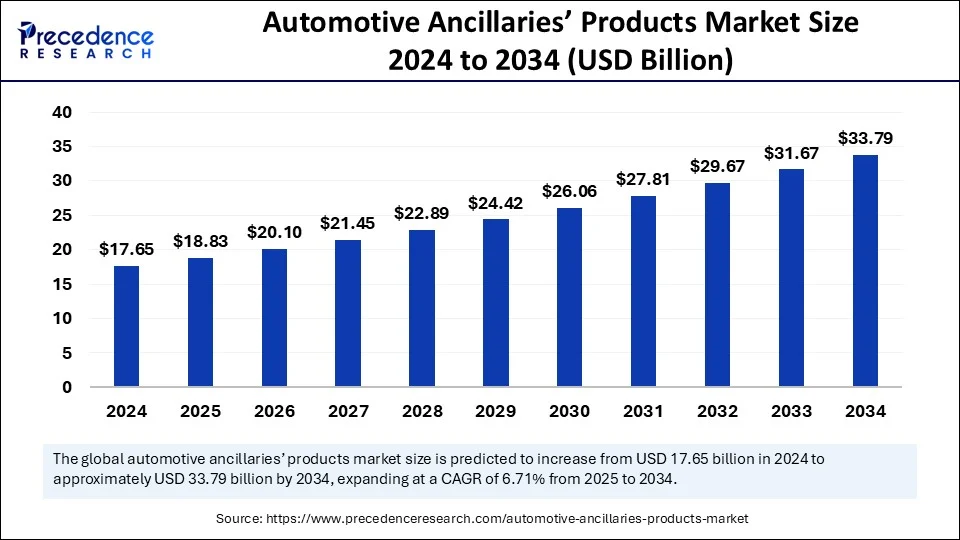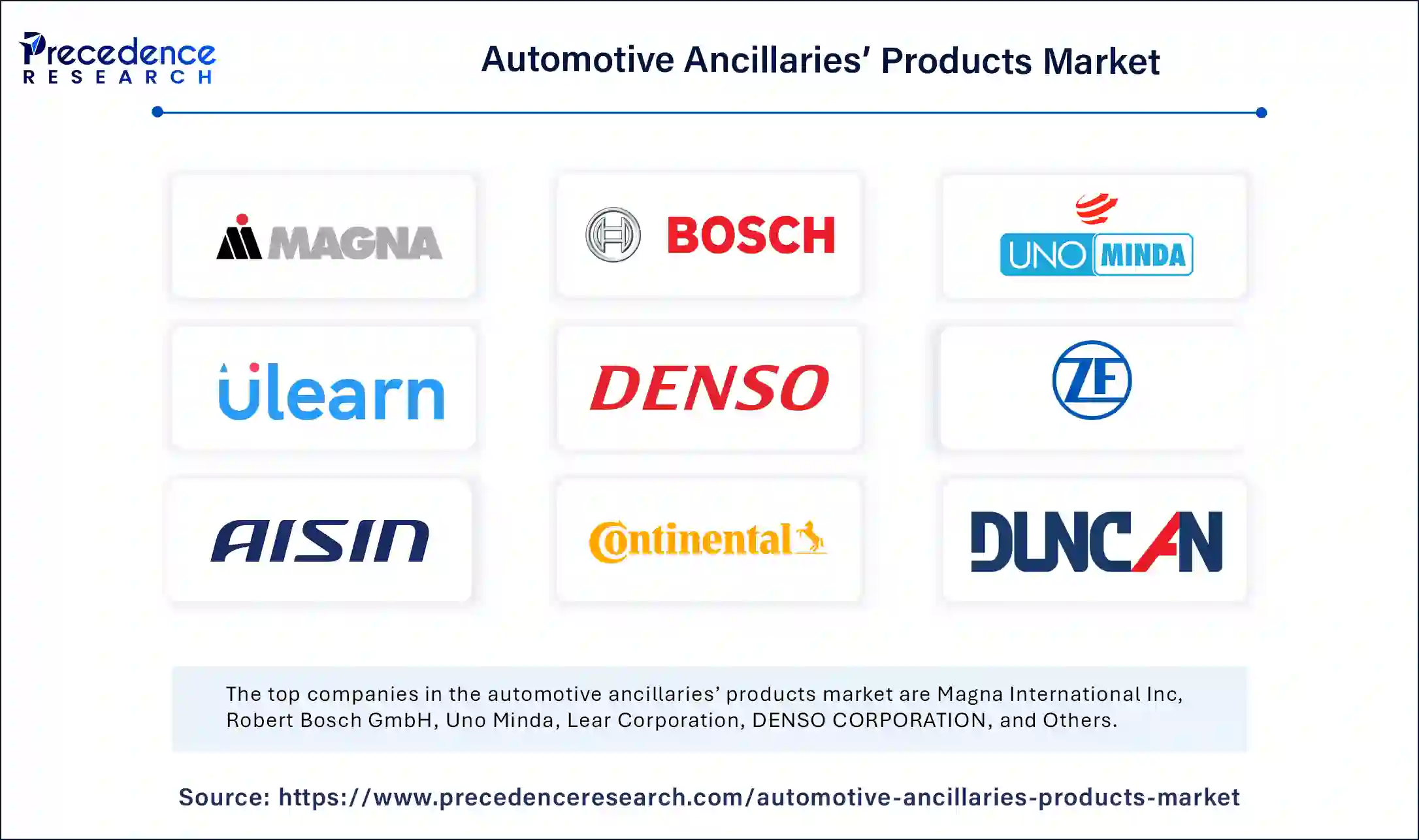The global automotive ancillaries’ products market size was estimated at USD 17.65 billion in 2024 and is expected to reach around USD 33.79 billion by 2034, growing at a CAGR of 6.71%.

Automotive Ancillaries’ Products Market Key Takeaways
-
Asia Pacific led the automotive ancillaries’ products market in 2024, holding the largest share of 39%.
-
North America is projected to register the fastest CAGR during the forecast period.
-
The engine, transmission, and suspension components segment held the largest market share by component in 2024.
-
The electrical parts segment is forecasted to grow at the highest rate over the coming years.
-
Passenger vehicles accounted for the majority market share of 73% by application in 2024.
-
The commercial vehicle segment is expected to experience significant growth during the forecast period.
-
The aftermarket segment dominated the distribution channel with a 75% market share in 2024.
-
The OEM segment is anticipated to see substantial growth throughout the forecast period.
The Automotive Ancillaries’ Products Market is experiencing robust growth driven primarily by the increasing demand for vehicles worldwide, particularly in emerging economies. Rising disposable incomes and urbanization have led to a surge in vehicle ownership, which in turn fuels the need for a wide range of ancillary products such as engine components, suspension parts, electrical systems, and more. Additionally, the ongoing shift toward electric vehicles (EVs) is creating new opportunities for automotive ancillary manufacturers to innovate and supply components specific to EVs, such as battery management systems and advanced electrical parts, further expanding the market.
Another important growth factor is the rapid technological advancement and integration of smart systems in vehicles. Modern vehicles are increasingly equipped with sophisticated safety features, infotainment systems, and advanced driver assistance systems (ADAS), all of which rely heavily on ancillary products. This trend is pushing manufacturers to develop high-precision, reliable components, thereby driving market expansion. Moreover, the automotive industry’s focus on lightweight and fuel-efficient vehicles has increased demand for specialized ancillary parts made from advanced materials, contributing to market growth.
Global supply chain improvements and increased investments in manufacturing infrastructure are also playing a significant role. Countries with strong automotive manufacturing bases, particularly in Asia Pacific, are attracting more investments in ancillary product production due to cost advantages and skilled labor availability. This regional growth is complemented by growing aftermarket services and vehicle maintenance needs, which sustain the demand for replacement parts and components, ensuring steady market momentum.
Lastly, stringent government regulations on vehicle emissions and safety standards are encouraging manufacturers to upgrade or replace existing vehicle components with higher-quality, compliant ancillary products. This regulatory environment stimulates innovation and quality improvements in ancillary products, which is positively impacting market growth by fostering a cycle of continuous demand and development.
Get this report to explore global market size, share, CAGR, and trends, featuring detailed segmental analysis and an insightful competitive landscape overview@ https://www.precedenceresearch.com/sample/5890
Role of AI in Automotive Ancillaries’ Products Market
AI is transforming the automotive ancillaries market by enabling smarter manufacturing processes, predictive maintenance, and enhanced quality control. Through AI-powered analytics and automation, manufacturers can optimize supply chains, reduce production costs, and improve product reliability, leading to more efficient and cost-effective operations.
Additionally, AI facilitates the development of advanced automotive components like intelligent sensors and adaptive systems that support electric and autonomous vehicles. This integration of AI-driven technologies helps ancillaries stay competitive by meeting evolving industry demands for safety, performance, and sustainability.
Automotive Ancillaries’ Products Market Scope
| Report Coverage | Details |
| Market Size by 2034 | USD 33.79 Billion |
| Market Size in 2025 | USD 18.83 Billion |
| Market Size in 2024 | USD 17.65 Billion |
| Market Growth Rate from 2025 to 2034 | CAGR of 6.71% |
| Dominated Region | Asia Pacific |
| Fastest Growing Market | North America |
| Base Year | 2024 |
| Forecast Period | 2025 to 2034 |
| Segments Covered | Component, Application, Distribution Channel, and Regions |
| Regions Covered | North America, Europe, Asia-Pacific, Latin America and Middle East & Africa |
Automotive Ancillaries’ Products Market Dynamics
Market Drivers:
The automotive ancillaries’ products market is propelled by the ongoing growth and transformation of the global automotive industry. Increasing vehicle production worldwide, driven by rising consumer demand for personal mobility and commercial transportation, directly boosts the demand for ancillary products such as components, parts, and accessories. Rapid technological advancements in automotive manufacturing, including the shift towards electric vehicles (EVs), autonomous driving, and connected cars, are encouraging the development and supply of sophisticated ancillary products.
The growing emphasis on vehicle safety, efficiency, and performance also drives demand for advanced components like sensors, braking systems, and lightweight materials. Furthermore, rising vehicle maintenance and aftermarket activities, fueled by increased vehicle ownership and longer vehicle life cycles, provide steady demand for replacement parts and accessories, reinforcing market growth.
Market Opportunities:
Significant opportunities exist for the automotive ancillaries market in expanding product portfolios tailored to emerging vehicle technologies. The transition to EVs presents a vast opportunity for ancillary manufacturers to develop components specifically designed for electric drivetrains, battery management systems, and thermal management. Additionally, the rise of autonomous and connected vehicles opens new avenues for supplying sensors, electronic control units, and infotainment system components.
Emerging markets, particularly in Asia-Pacific, Latin America, and Africa, present growth potential due to increasing vehicle production, expanding middle-class populations, and improving road infrastructure. These regions also offer opportunities in the aftermarket segment as vehicle fleets grow. Companies that can innovate with lightweight, durable, and cost-effective materials are poised to capture market share. Collaborations between OEMs and ancillary suppliers to ensure seamless integration of new technologies also create strategic growth pathways.
Market Challenges:
The automotive ancillaries market faces several challenges that could hinder growth. One of the main issues is the high cost and complexity of adapting to rapid technological changes, especially with the shift towards EVs and autonomous vehicles. Ancillary suppliers need to continually invest in research and development to keep pace with evolving vehicle architectures and stringent regulatory standards, which can be financially taxing for small and medium enterprises.
Supply chain disruptions, as experienced globally in recent years, pose risks to timely production and delivery of components, impacting manufacturers’ ability to meet market demand. Additionally, price competition, especially from low-cost manufacturers in certain regions, pressures profit margins. Regulatory compliance related to safety, emissions, and environmental standards varies widely across regions and adds layers of complexity to manufacturing and product certification. Furthermore, the trend of OEMs vertically integrating or developing in-house component manufacturing can limit opportunities for independent ancillary suppliers.
Regional Outlook:
Asia-Pacific dominates the automotive ancillaries market, driven by major automotive manufacturing hubs in China, India, Japan, and South Korea. The region benefits from a large and growing vehicle market, robust manufacturing infrastructure, and supportive government policies encouraging automotive production and export. North America and Europe also hold significant shares, supported by well-established automotive industries and high demand for advanced vehicle technologies. Europe’s focus on sustainability and emission reduction fuels demand for innovative ancillary products that support electric and hybrid vehicles.
North America, particularly the U.S., is a key market for aftermarket automotive products due to high vehicle ownership and long vehicle retention periods. Latin America and the Middle East & Africa regions are emerging markets, showing increasing demand due to urbanization, rising disposable incomes, and infrastructure development, although economic and political instability in some areas may temper growth. Overall, regional dynamics, government regulations, and consumer preferences will shape the future trajectory of the automotive ancillaries market globally.
Automotive Ancillaries’ Products Market Companies

- Magna International Inc
- Robert Bosch GmbH
- Uno Minda
- Lear Corporation
- DENSO CORPORATION
- ZF Friedrichshafen AG
- AISIN CORPORATION
- Continental AG
- Duncan Engineering Ltd
- Nippon
Segments Covered in the Report
By Component
- Engine Transmission and Suspension Components
- Electrical Parts
- Sheet Metal Parts and Body and Chassis
- Cleaning, Maintenance, and Repair of Products
- Others
By Application
- Commercial Vehicle
- Passenger Vehicle
By Distribution Channel
- OEM
- Aftermarket
By Region
- North America
- Asia Pacific
- Europe
- Latin America
- Middle East and Africa
Also Read: Network Slicing Market
Source: https://www.precedenceresearch.com/automotive-ancillaries-products-market